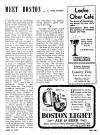
Home Page Meet Boston Menu Index
|
MEET BOSTON Friday, June 27, 1941 in What's New In Town W. J. Sidis |
On the part of Cambridge St. that used to be part of Court Street (between Scollay Square and Bowdoin Square), there stood, in the Seventies, an electrical supply store . . . an extremely unusual thing for those days, when there were few electrical appliances known. In its basement and attic resided a couple of assistants who worked in the store and got their rooms as part of their pay. And there, at night when the store was closed, went on electrical experiments not precisely within the scope of the store’s business. The two store assistants were working to perfect a kind of telegraph which would send several messages at once over one wire, by using different wavelengths. They did not get their telegraph, but the surprise came when words issued from the instrument at the basement end of the wire. Thus, in March, 1875, was made a telephone. About a year later came the first paying telephone subscriber . . . a business man living in East Somerville, who installed a pair of telephones to connect his home with his office in Boston. In 1879, a telephone wire was extended from Boston to Salem, for an exhibit in which people in Boston spoke to a Salem audience, and the Boston Globe printed, in parallel columns, “What was said” and “What was heard.” The little “telegraph” experiment in that place near Bowdoin Square has now grown into a network of telephone extending round the world. While, next door to where the original instrument was located stands Boston’s great telephone building.
*
Probably the largest single pier structures ever built anywhere is the so-called Mystic Docks in Charlestown, nearly a mile long and with a width about a third of its length. There are many smaller piers attached to the large one, where ships can dock. Most of the area of the larger pier is a maze of freight tracks, originally built to give the products of Lowell and the upper Merrimac direct access to ships in Boston Harbor. A close runner-up is the “Boston Wharf” in South Boston. This includes the immense area from Summer Street to the Merchants and Miners landing, and from Fort Point Channel almost to the Commonwealth Pier. This region is a counterpart of the one in Charlestown, and it is now almost forgotten that it is actually a pier.